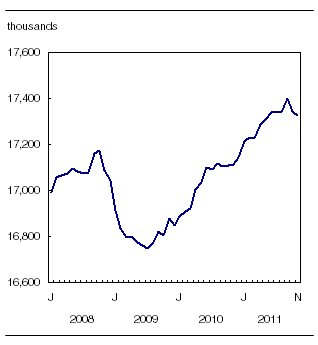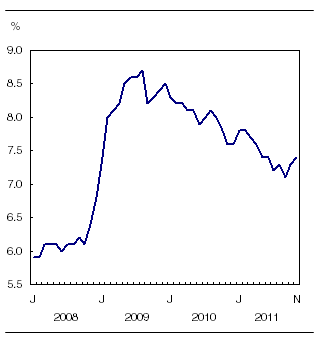Labour Force Survey
Archived Content
Information identified as archived is provided for reference, research or recordkeeping purposes. It is not subject to the Government of Canada Web Standards and has not been altered or updated since it was archived. Please "contact us" to request a format other than those available.
Related subjects
-
[an error occurred while processing this directive]
Following a notable decrease the previous month, employment edged down 19,000 in November, and the unemployment rate rose by 0.1 percentage points to 7.4%. Despite the recent declines, employment was up 1.2% (+212,000) from 12 months earlier.
Employment

A decline of 53,000 in part-time work was partially offset by an increase of 35,000 in full-time. Compared with a year earlier, the number of part-time workers was down 1.9% (-62,000), while full-time employment grew by 2.0% (+274,000). Over the same period, the total number of hours worked increased at the same rate as total employment (+1.2%).
Employment declined in Quebec and Saskatchewan in November, while it increased in Nova Scotia. There was little change in the other provinces.
Note to readers
Labour Force Survey (LFS) estimates are based on a sample, and are therefore subject to sampling variability. Estimates for smaller geographic areas or industries will have more variability. For an explanation of sampling variability of estimates, and how to use standard errors to assess this variability, consult the "Data quality" section of the publication Labour Force Information (71-001-X, free).
Statistics Canada is moving to one release time, 8:30 a.m., for all data releases in The Daily. This will mean a change in the release time for the LFS, which is currently 7:00 a.m. This change will be implemented with the release of LFS data on April 5, 2012.
In November, there were employment losses in retail and wholesale trade, as well as business, building and other support services. These losses were partially offset by increases in "other services" (such as personal services and repair and maintenance), as well as in construction; natural resources; and utilities.
There were fewer self-employed workers in November (-28,000). Compared with a year earlier, most of the employment growth was among private sector employees (+1.9%), as employment was little changed among public sector employees (+0.4%) and the self-employed (-0.3%).
Employment declined among core-aged men and youths, while there were gains among women aged 55 and over.
Unemployment

Chart description: Unemployment
Losses in services partly offset by increases in goods sector
Employment in the service sector declined in November, with decreases in retail and wholesale trade (-34,000) as well as in business, building and other support services (-29,000). At the same time, there were employment gains of 36,000 in "other services" such as personal services and repair and maintenance.
Despite the decline in November, employment in the service sector rose by 1.3% over the past 12 months, with steady increases in accommodation and food services (+6.5%) as well as professional, scientific and technical services (+5.1%).
In November, there were more workers in the goods sector, with gains in construction (+20,000); natural resources (+10,000); and utilities (+8,000).
In the 12 months to November, employment in the goods sector increased 0.8%. Over the period, there was notable growth in natural resources (+8.3%) and construction (+2.2%). In manufacturing, employment was slightly below its level of 12 months earlier (-0.8%).
Employment declines in Quebec and Saskatchewan
Employment in Quebec fell by 31,000 in November, pushing the unemployment rate up 0.3 percentage points to 8.0%. The bulk of the decline was in wholesale and retail trade. This month's decrease leaves employment in the province at about the same level as November 2010.
The only other province with a notable employment decrease in November was Saskatchewan (-4,200). This pushed the unemployment rate in the province up by a full percentage point to 5.1%. With this month's decline, employment in Saskatchewan was similar to its level one year earlier.
In November, employment increased by 4,400 in Nova Scotia. Despite this increase, the unemployment rate in the province was unchanged at 8.6%, as more people were participating in the labour market.
Following a large decline in October, employment in Ontario edged up by 17,000 in November. At the same time, the unemployment rate declined 0.2 percentage points to 7.9%. Over the past 12 months, employment in the province has grown by 1.5% (+97,000), slightly higher than the national average of 1.2%.
Employment in Alberta edged up in November, and the unemployment rate was 5.0%. Compared with November 2010, employment grew faster in Alberta than in any other province, at 4.8%.
Employment declines among core-aged men and youths
In November, employment declined by 20,000 among core-aged men (25 to 54), leaving employment for this group slightly above its level of 12 months earlier (+0.5%). Among core-aged women, while little changed in November, employment grew 1.3% over the past 12 months.
Employment also fell in November among youths aged 15 to 24 (-18,000). Compared with one year earlier, however, youth employment was up 1.3%.
There were more women aged 55 and over working in November (+20,000), bringing total growth for this group to 2.1% over the past 12 months. For men in the same age group, despite little change in November, employment increased by 2.9% over the past 12 months.
Available on CANSIM: tables 282-0001 to 282-0042, 282-0047 to 282-0063, 282-0069 to 282-0095 and 282-0100 to 282-0121.
Definitions, data sources and methods: survey number 3701.
A more detailed summary, Labour Force Information (71-001-X, free), is now available online for the week ending November 12. From the Key resource module of our website under Publications, choose All subjects, then Labour.
Data tables are also now available online. From the Subject module of our website, choose Labour.
The next release of the Labour Force Survey will be on January 6, 2012.
For more information, contact Statistics Canada's National Contact Centre (toll-free 1-800-263-1136; 613-951-8116; infostats@statcan.gc.ca), Communications Division.
To enquire about the concepts, methods or data quality of this release, contact Vincent Ferrao (613-951-4750; vincent.ferrao@statcan.gc.ca) or Danielle Zietsma (613-951-4243; danielle.zietsma@statcan.gc.ca), Labour Statistics Division.
- Date modified:
